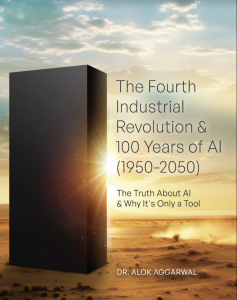
New Book Offers a Comprehensive Analysis of the Future of Work in 2050
Researcher and innovator Alok Aggarwal’s new book addresses the impact of Artificial Intelligence on employment trends and emerging industries
SAN JOSE, CALIFORNIA, USA, April 8, 2024 /EINPresswire.com/ -- As we stand on the precipice of the Fourth Industrial Revolution, marked by the rise of Artificial Intelligence (AI) and automation, concerns about the profound shifts in the job market have become increasingly urgent. Alok Aggarwal’s new book, "The Fourth Industrial Revolution & 100 Years of AI (1950-2050),” asserts that the last decade has seen a surge in discussions surrounding the potential displacement of jobs, with studies indicating that up to 47% of total US employment is at high risk of automation within the next couple of decades. This alarming statistic, detailed by Frey and Osborne in 2013, suggests that around 85 million jobs in the United States alone could be lost by 2033, prompting discussions regarding massive job losses in human society and the potential introduction of Universal Basic Income (UBI) to address the socio-economic fallout.The sixteenth chapter of Aggarwal’s book, titled “Jobs Likely to be Lost and Gained During the Current Industrial Revolution,” explores the complex interplay of tectonic shifts that will shape the future job landscape, including the world's ageing population, the impact of AI, robotics, and automation, climate change mitigation efforts, and the creation of new jobs in emerging economies.
Key takeaways from this chapter include:
Increase in labor supply during 2021-2050: The global working population will increase from 3.2 billion in 2021 to 3.9 billion in 2050 and hence to maintain the status quo, an additional 700 million jobs need to be created. In fact, more than 50 countries may have a constant or declining population by 2050. This will force them to rely on computers, Robots, and other means of automation.
Increase in labor demand during 2021-2050: Demand of human labor will be governed by the following monumental factors: Ageing and slowly growing population: Around 75 million healthcare workers globally will be required by 2050 because of the ageing population.
• Loss of jobs due to Data Science, AI, and automation: Approximately 395 million jobs are likely to be lost due to AI, Robotics, and automation by 2050.
• Jobs created due to Data Science, AI, and automation: About 135 million jobs in Data Science, AI and Robotics are likely to be created by 2050.
• Emergence of a new industry of data labelers and annotators: Approximately 15 million jobs will be created in this newly emerging industry of data analysts.
• Jobs created while combatting climate change: Almost 360 million jobs may be required if the world spends 40 trillion Dollars (i.e., 0.5% of its annual GDP) during 2021-2050 to steadfastly battle climate change.
• Jobs lost if climate change is not fought aggressively: On the other hand, if humans do not combat climate change aggressively, then 216 million people will be displaced globally and at least 80 million will lose their jobs.
• Jobs created in six emerging economies to upgrade their infrastructure: During 2023-2050, emerging countries are expected to grow at 6% annually. If they invest 2% of their GDP in improving their current infrastructure, at least 725 million jobs will be created by 2050.
• The fourth industrial revolution is likely to foster new industries: It is quite likely that additional key inventions will emerge during the fourth industrial revolution that will lead to entirely new industries (e.g., flying vehicles). Since their effect is unknown, it is not included here.
Hence, we as humans may be working harder in 2050 than we are currently, which is contrary to the views held in the contemporary media. In addition, we will need people to migrate freely from one country to another and receive all the help that we can get from AI, Robotics, and automation. Finally, as mentioned in Chapter 16, since these estimates are for the next 27 years, most of these numbers should only be considered from a qualitative perspective.
Overall, the book, “The Fourth Industrial Revolution & 100 Years of AI (1950-2050)” provides a concise yet comprehensive exploration of AI, covering its origins, evolutionary trajectory, and its potential ubiquity during the next 27 years. Beginning with an introduction to the fundamental concepts of AI, subsequent chapters delve into its transformative journey with an in-depth analysis of achievements of AI, with a special focus on the potential for job loss and gain. The latter portions of the book examine the limitations of AI, the pivotal role of data in enabling accurate AI systems, and the concept of "good" AI systems. It concludes by contemplating the future of AI, addressing the limitations of classical computing, and exploring alternative technologies (such as Quantum. Photonics, Graphene, and Neuromorphic computing) for ongoing advancements in the field. This book is now available in bookstores and online retailers in Kindle, paperback, and hard cover formats.
About the Author and Scry AI: Dr. Aggarwal is the founder, CEO, and Chief Data Scientist of Scry AI, which provides innovative AI-based products, solutions, and services to enterprises across the globe. Before starting Scry AI, he co-founded Evalueserve (www.evalueserve.com) which provides research and analytics services worldwide. He received his Ph. D. from Johns Hopkins University and worked at IBM’s T. J. Watson Research Center during 1984 and 2000. He has written more than 120 research articles and has been granted eight patents. For more information, please visit: www.scryai.com
Alok Aggarwal
Scry AI, Inc.
+1 9149804717
email us here
Visit us on social media:
Facebook
Twitter
LinkedIn
Instagram
YouTube
EIN Presswire does not exercise editorial control over third-party content provided, uploaded, published, or distributed by users of EIN Presswire. We are a distributor, not a publisher, of 3rd party content. Such content may contain the views, opinions, statements, offers, and other material of the respective users, suppliers, participants, or authors.


